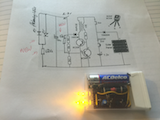Mon Jun 20 15:30:29 PDT 2016
Joule Thief in Obligatory Tic Tac Box with Flickering LEDs
The 'Big Clive' Joule Thief runs to low voltages - as is well known - so if you want to extract energy from an old AA battery and have something possibly useful with that energy happen - a Joule Thief is a perfect vehicle to that end.
There is lots of experimentation documented on the web with different approaches and circuit variations. Some circuits yield improved efficiency and others provide enhancements like current or voltage control.
Here is a Joule Thief variant I put together at the weekend, as one does. It uses two flickering light emitting diodes (LEDs) taken from Dollar Store 'tea light' plastic candles (2 for one dollar). These Dollar Store candles are in themselves wonderful devices. They use 3 volt 2032 lithium cells - so perhaps their only limitation is that they run for a decidedly finite 5 days (according to the packet). The Joule Thief circuit allows you to use AA batteries that are no longer able to energize modern electronic equipement - the inductor based Joule Thief circuit extracts energy from the cell all the way down to about 0.4 volts (and lower if you are prepared to seek out special transistors).
 |
The circuit used is shown in the image near this text (click on the image for a larger view). This is an extension of the Joule Thief circuit, adjusted to provide a specific output voltage. In the original Talking Electronics version (from here), the target voltage was 5 volts. The place of the solar cell in the original circuit has been taken by a 1.5 (in principle) AA battery. For the flickering LEDs, a voltage of about 3 volts was required, so I changed the resistor network of the original circut a little so that the control of the oscillating transistor cuts in at 3 volts. This means that the output is a steady 3 volts. I also added a series resistor for the LEDs - I did this to mimic the behavior of the original flickering LEDs in the Dollar Store tea lights - super bright is not particularly candle like.
As a finishing touch, American style Tic Tac boxes are the perfect enclosure for a small circuit - providing an aesthetically satisfying blend of transparency, amateurishness, and thriftiness. Once installed in the Tic Tac box the flickering LEDs can be conveniently covered with the plastic tube fake flame cover of the original lights, yielding a quasi-nixie tube flickering display - both fetching and enchanting.
The flickering LEDs contain a chip which handles the random fluctuations, as discussed here. So although this is a two transistor Joule Thief, it contains two substantial integrated circuits as well.
From a chemical perspective, what happens in an alkaline battery is that zinc is oxidized to form zinc oxide, and manganense in the form of MnO2 is reduced. (The name 'alkaline' refers to the fact that their are hydroxide ions added to the water in the battery in the form of potassium hydroxide). The basic chemical reaction of an alkaline battery is:
Zn(s) + 2MnO2(s) = ZnO(s) + Mn2O3(s)
This reaction liberates a fair amount of energy as the zinc is effectively burned, and that energy is released in the form of electrons flowing between the zinc and the MnO2. That is the energy that powers the Joule Thief and flickers the LEDs.
As an alkaline battery ages, its internal resistance increases, reducing the voltage that is available to drive electronic devices. The Joule Thief, because it boosts voltage using a transformer, is able to keep going with lower voltages than many pieces of equipment. Hence the Joule Thief is the perfect device for squeezing the last few drops of zinc oxidation from old batteries prior to handing them over to the recycler.
The Joule Thief on the video above has been running for about 24 hours. I may exert myself and measure how long it takes to run down sufficiently to be unable to light the LEDs - I am expecting several weeks of run time. I will report back on my observations.